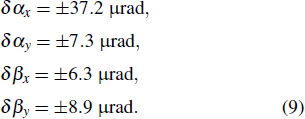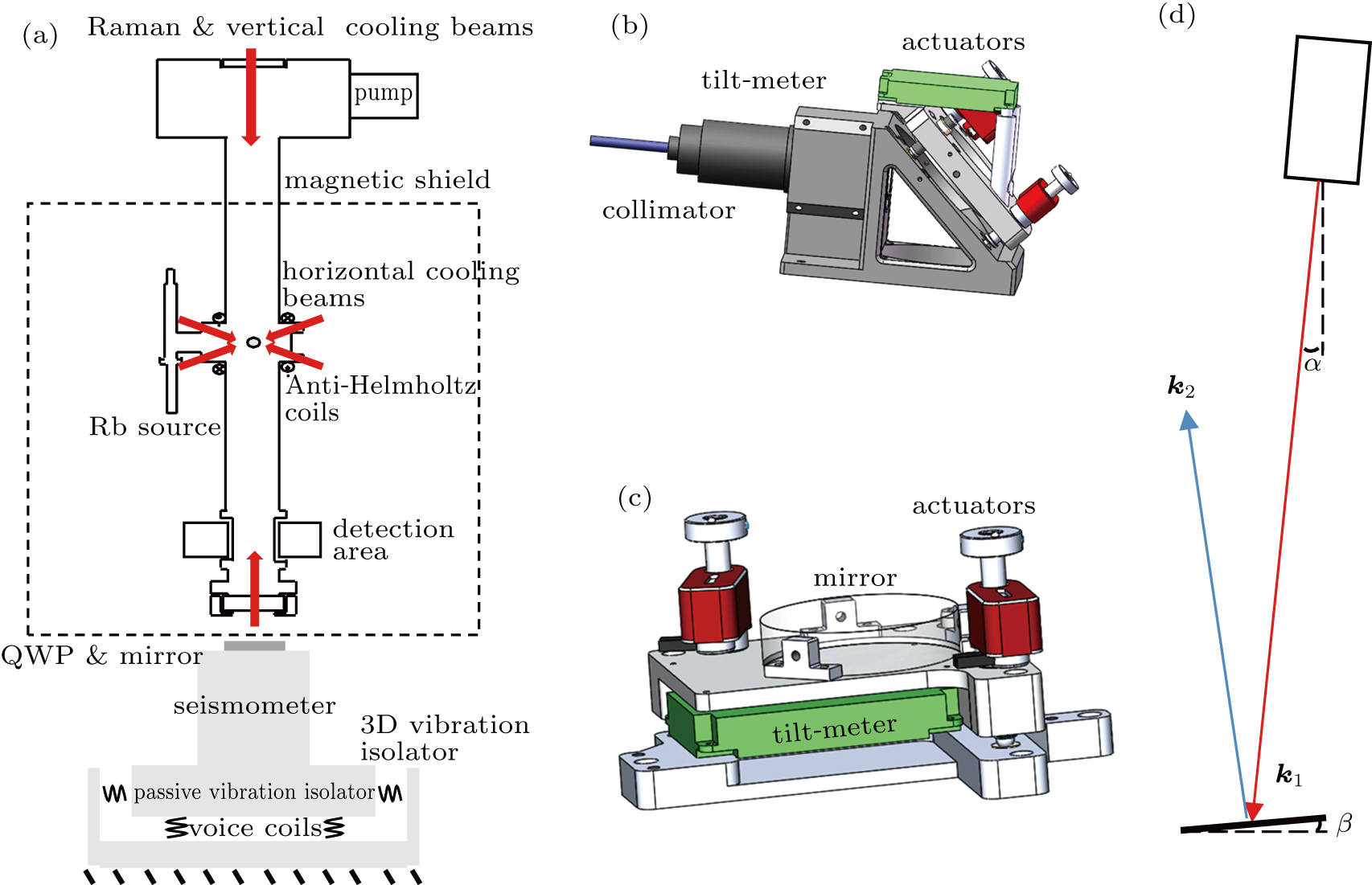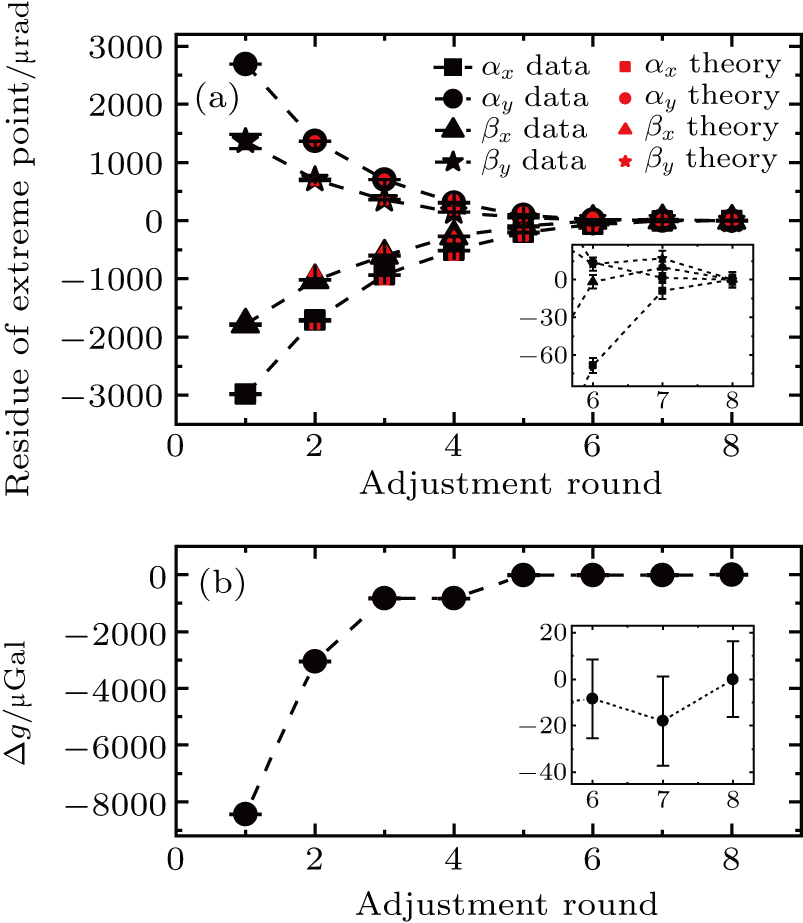† Corresponding author. E-mail:
Project supported by the National Key R&D Program of China (Grant No. 2016YFA0301601), the National Natural Science Foundation of China (Grant No. 11674301), Anhui Initiative in Quantum Information Technologies, China (Grant No. AHY120000), and Shanghai Municipal Science and Technology Major Project, China (Grant No. 2019SHZDZX01).
For an atomic gravimeter, the measured value of the Earth’s gravity acceleration g is the projection of the local gravity on the direction of Raman laser beams. To accurately measure the g, the Raman laser beams should be parallel to the g direction. We analyze the tilt effect of the Raman beams on g measurement and present a general method for the tilt adjustment. The systematic error caused by the tilt angle is evaluated as 0 (+0, –0.8) μGal (1μGal = 10 nm/s2) and the drift is also compensated in real time. Our method is especially suitable for the portable atomic gravimeter which focuses on the mobility and field applications.
Measurement of the Earth’s gravity acceleration g is important for numerous scientific studies and applications, such as the new definition of kilogram,[1] geodesy, geophysics, resources exploration,[2] and autonomous navigation.[3] The best-performing gravimeters at present time include relative gravimeters[4,5] and falling corner cube gravimeters[6–8] based on optical interferometry. With these high performing instruments, researchers can measure g in a very high sensitivity and accuracy (up to μGal level). Cold atomic gravimeters based on matter wave interferometry have been rapidly developed since the 1990s[9–20] and have achieved extremely high sensitivity[21] and stability[22] that had advanced to the high performing falling corner cube gravimeters. The comparison of absolute gravimeters shows that the degree of equivalence and the uncertainty of atomic gravimeters also reach several μGal (1 μGal = 10 nm/s2)[23] and ready to be used in real applications.
Based on the two-photon Raman transition between two hyperfine levels of the atom ground state, a π/2–π–π/2 Raman pulse sequence splits, reflects, and recombines the atomic wave packet for the interferomety.[9] The phase shift due to the gravity is as follows:

Researchers have made considerable efforts to correct the systematic error caused by tilt, such as calibrating the direction of the incident beam with a liquid surface,[24] determining the orientation of the mirror with an electronic bubble level,[11] calibrating the directions of the Raman beams with a beam-splitter and a CCD camera,[25] and adjusting the reflected beam overlap the incident beam with a photo-diode.[26] These methods are suitable for atomic gravimeters in labs or fixed stations, but too complicated for the portable atomic gravimeters. There are also some methods that meet the portable demand. For example, use a corner cube mirror to make the reflected beam overlap the incident beam,[27] but may cause worse wavefront aberrations;[28–30] and adjust the directions of the incident beam and reflected beam for parabola fitting respectively,[31] but the direction of the reflected beam is not independent of incident beam, which induces a cross term and makes the adjustment invalid.
In this paper, we provide a common approach for the tilt adjustment of the Raman laser beams in a portable absolute atomic gravimeter. By applying this approach, the systematic error of our portable atomic gravimeter USTC-AG02 according to the tilt is effectively eliminated, becomes 0 (+0, -0.8) μGal considering the uncertainty. Also, with continuous tilt monitoring, the compensation for the measured g value is applied to enhance the long term accuracy. This approach especially fit for the gravimeter adjustment in the field applications.
The absolute atomic gravimeter USTC-AG02 is based on the Mach–Zehnder type atom interferometer. The schematic diagram of the gravimeter’s sensor is shown in Fig.

The Raman beams entered the vacuum chamber through a fiber collimator with a 45° mirror (Fig.
The direction analysis of the effective wave-vector keff is shown in Fig.




As the four angles can be controlled by the four actuators independently, we can tune one while maintaining the other three fixed with monitoring the measured g value. For each round, we tune the four angles one by one in serial and record the measured g-value accordingly. Thus, we can get four sets of g-angle curves and make the parabolic fit to obtain the extreme point for each. When varying αx and keep the other three fixed, equation (


From the analysis we know that only the single adjustment round cannot correct the Raman beams along vertical direction precisely and cannot eliminate the tilting induced systematic error. After applying many adjustment rounds and setting the angles to the corresponding extreme points for each round, the four tilt angles decrease to a convergence value, as seen in Table
| Table 1. The residues of the four tilt angles, which vary according to the adjustment rounds. . |
After the tilting angles are set to the extreme points at the end of each round, we start to perform the next adjustment round. The extreme points with varying adjustment rounds is shown in Fig.

We have measured g at the beginning of each adjustment round, as shown in Fig.
During the continuous measurement of the gravity acceleration over long time, we have observed the drifts of the tilting angles due to the relaxing of the mechanical structure of the gravimeter, which also affects the measurement results. The drifts of the four tilting angles are continuously monitored by the tilt meters. Figure
 | Fig. 4. Variations over time of the four tilt angles. (a) The observed drifts of four angles αx, αy, βx and βy. (b) The calculated drift of g-value corresponding to the drifts of the tilting angles. |
The continuous measurement of g in our laboratory starts on December 12, 2018. We take the data for the first 36 hours, as shown in Fig. 
| Table 2. Comparison between the performances without and with tilt compensation (TC). . |
We have found a practical approach to precisely adjust the Raman laser beams in an absolute atomic gravimeter. By applying the multi-stage adjustment, the measured g gradually converges to an extreme maximum value, which tells us that the pointing of the Raman lasers is parallel to g direction. For our gravimeter USTC-AG02, the systematic error due to the tilting has been well eliminated and becomes 0 (+0, –0.8) μGal considering the uncertainty. The long-term drift of the tilting angle has also been monitored and the compensation was applied during the continuous measurement of g. Our method is especially suitable for the compact and portable gravimeters used for the mobile gravity measurements and observations.
| [1] | |
| [2] | |
| [3] | |
| [4] | |
| [5] | |
| [6] | |
| [7] | |
| [8] | |
| [9] | |
| [10] | |
| [11] | |
| [12] | |
| [13] | |
| [14] | |
| [15] | |
| [16] | |
| [17] | |
| [18] | |
| [19] | |
| [20] | |
| [21] | |
| [22] | |
| [23] | |
| [24] | |
| [25] | |
| [26] | |
| [27] | |
| [28] | |
| [29] | |
| [30] | |
| [31] |





